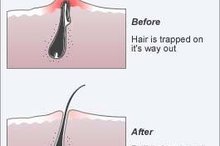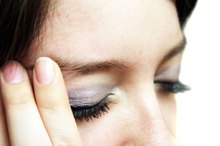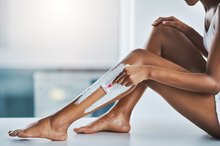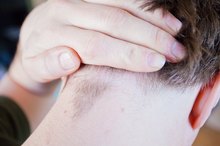What does fact checked mean?
At Healthfully, we strive to deliver objective content that is accurate and up-to-date. Our team periodically reviews articles in order to ensure content quality. The sources cited below consist of evidence from peer-reviewed journals, prominent medical organizations, academic associations, and government data.
- Pseudofolliculitis barbae and related disorders.
- Pseudofolliculitis barbae and related disorders.
- Pseudofolliculitis Barbae
- Defining pseudofolliculitis barbae in 2001: A review of the literature and current trends
- Folliculitis
The information contained on this site is for informational purposes only, and should not be used as a substitute for the advice of a professional health care provider. Please check with the appropriate physician regarding health questions and concerns. Although we strive to deliver accurate and up-to-date information, no guarantee to that effect is made.
How to Treat Ingrown Hairs in the Pubic Area
Ingrown hairs are unsightly, painful, inflamed and even infected bumps, especially when they occur on the sensitive skin in your pubic region 6. But what are they? A hair becomes ingrown when the tip of the hair gets folded back into the skin at the root.
If you shave, wax or use another form of hair removal in the pubic area, you increase the likelihood of an ingrown hair, as the hair is shortened and can more easily bend into the skin 4. Sometimes ingrown hairs will take care of themselves if the hair grows long enough and you don't itch the affected area.
But you can also take matters into your own hands if it becomes too uncomfortable. If treated properly, you can get rid of ingrown hairs in your pubic region at home, but if pus, bleeding or other signs of infection occur, you should seek medical help.
Read more about how to clear up ingrown hairs.
Causes and Risk Factors for Ingrown Hairs
An ingrown pubic hair causes a painful, red bump that looks a lot like a pimple. There may be pus in the bump, but sometimes the bump may be hard instead of pus filled.
The pus is caused by your body's attempt to fight what it considers foreign — the hair that has re-entered the skin. These pustules range in size from two to four millimeters and can be painful. They may itch or be slightly darker than the surrounding skin.
Most ingrown pubic hairs are caused by shaving or waxing the hair in the area 4. However, they are sometimes caused by tight clothing rubbing against and irritating the area.
- An ingrown pubic hair causes a painful, red bump that looks a lot like a pimple.
- Most ingrown pubic hairs are caused by shaving or waxing the hair in the area 4.
Treatment Options for Ingrown Hairs
How to Remove Perianal Hair
Learn More
You can deal with the inflammation by applying a hot cloth or compress to the ingrown hair 6. This treatment might soften the hair enough for it to rise to the surface where you can use a pair of sterilized tweezers to pull it out.
If the hair doesn't surface right away, you may need to wait a few days for it to get long enough for you to pull out.
Don't try to force the hair out if there's nothing visible to grab, since it could cause permanent scarring. Follow these steps to safely remove the ingrown hair:
- Stop any hair removal methods, at least in the area surrounding the ingrown hair 4. Shaving, plucking or any other hair removal method can make the irritation worse and introduce bacteria to the ingrown hair follicle 4. 2.
Wet a clean washcloth with warm water. Place it over the ingrown hair for 10 to 15 minutes 6.
Do this at least once a day to help soften the skin over the ingrown hair.
- Lather the ingrown hair area with a mild soap and warm water. Gently rub the area with a fresh, wet washcloth. Apply minimal pressure but rub in a circular motion for 10 to 15 seconds. This technique can soften the skin and help the hair protrude from the skin. If you notice this irritates the area more, skip this step. 4. Apply a thin layer of antibiotic ointment once or twice per day, especially following the warm compress and soap. The ointment can reduce the risk of infection of the hair follicle. 5. Examine the ingrown hair carefully each day. Attempt to withdraw the hair only when a loop or bend of the hair is visible. When this appears, disinfect a pair of tweezers with a cotton ball soaked in rubbing alcohol. Rub the cotton ball over the tweezers.
- Grasp the center of the loop of hair with the tweezers.
Turn the tweezers in either direction to loosen the tip of the hair and force it to pop out of the skin. Another method is to take one point of the tweezers, insert it into the loop of hair and slowly lift upward. This is different from plucking the hair; the intention is to gently get the tip of the hair to come out of the skin. 7. Grasp the tip of the hair with the tweezers once it comes out of the skin. Gently pull straight up to withdraw the hair. 8. Cleanse the skin with soap and water after removing the hair. 9. Pat the area dry and apply a thin layer of triple antibiotic ointment.
Read more about home treatment for ingrown vaginal ingrown hairs.
- You can deal with the inflammation by applying a hot cloth or compress to the ingrown hair 6.
- Lather the ingrown hair area with a mild soap and warm water.
- Turn the tweezers in either direction to loosen the tip of the hair and force it to pop out of the skin.
After Care and Considerations for Ingrown Hairs
Observe the site of the ingrown hair for several days to watch for signs of infection. Should the skin become reddened, full of pus or extremely painful, contact a health care professional for skin infection treatment.
You can minimize the risk of infection by using hydrocortisone or anti-itch cream, witch hazel or pure aloe vera on the area to prevent you from itching the affected area. Scratching or digging at the ingrown hair can introduce bacteria into the area. If you do scratch at the area, apply more of the antibiotic ointment to the area to help minimize the risk of infection.
If you haven't removed any hair from the affected area or if you don't think you should have an ingrown hair in the area, you should make an appointment with a doctor to determine the cause of the lesions 6. Some sexually transmitted diseases can cause lesions on the pubic area.
- Observe the site of the ingrown hair for several days to watch for signs of infection.
- You can minimize the risk of infection by using hydrocortisone or anti-itch cream, witch hazel or pure aloe vera on the area to prevent you from itching the affected area.
Prevention of Ingrown Hairs
How to Get Rid of an Infected Ingrown Hair
Learn More
Preparation is the key to preventing ingrown pubic hairs caused by shaving 47. By following these steps, you can hopefully prevent ingrown pubic hairs.
- Trim away longer portions of hair with manicure scissors or an electric trimmer. Hair is easier to remove when it's shorter, which means hair removal is also easier on your skin 4. 2. Soak in a warm bath for at least five minutes to soften the coarse and curly hair of your public region. Softened hairs are less sharp and less likely to coil into your skin.
- Gently exfoliate the skin around your public region before hair removal 4. Use a loofah, washcloth or exfoliating scrub as it helps prevent ingrown hairs and releases hairs already starting to grow inward. 4. Apply a lubricating oil or lotion to the area, like a pre-shave lotion or baby oil.
This serves two purposes. It further softens your hair, and it's less easily washed away by water than shave cream, offering a more reliable layer of protection from friction.
5.
Apply your regular shaving cream on top of your shave oil, but avoid soaps, shampoos or conditioners. Use a thick, heavy lathering product designed for shaving. 6. Pull the skin tight and pass over each area only once with a new, sharp razor. Shave in the direction of hair growth for the least amount of irritation and avoid making multiple passes over the same area as this can lead to ingrown hairs. 7. Wash and pat dry, then apply a moisturizing skin cream that contains salicylic or glycolic acid. This helps to prevent ingrown hairs, irritation, pimples and razor burn.
- Preparation is the key to preventing ingrown pubic hairs caused by shaving 4.
Related Articles
References
- Pseudofolliculitis barbae and related disorders.
- Pseudofolliculitis Barbae
- Defining pseudofolliculitis barbae in 2001: A review of the literature and current trends
- Pubic Hair Removal: Shaving
- Folliculitis
- How to Deal with Infected Ingrown Pubic Hair
- Treating and Preventing Ingrown Vaginal Hair
- MedlinePlus. Acne.
- Cleveland Clinic. Ingrown hair. Updated February 28, 2018.
- Merck Manuals. Ingrown beard hairs. Updated October 2019.
- Cleveland Clinic. Ingrown hair: Management and treatment. Updated February 28, 2018.
- Ogunbiyi A. Pseudofolliculitis barbae; current treatment options. Clin Cosmet Investig Dermatol. 2019;12:241-247. doi:10.2147/CCID.S149250
- MedlinePlus. Folliculitis. Updated October 8, 2018.
- Zaenglein AL, Pathy AL, Schlosser BJ, Alikhan A, Baldwin HE, et. al. Guidelines of care for the management of acne vulgaris. Journal of the American Academy of Dermatology. 2016; 74(5): 945-73. doi:10.1016/j.jaad.2015.12.037
Writer Bio
Rachel Grice is a contributing fitness editor for Livestrong.com and a certified yoga instructor. Previously, she was the science section editor and titling associate for several other sections of Demand Media Studios, including fitness, nutrition and technology. She completed her undergrad education at the University of Southern California and has worked for Men's Health, FitPregnancy and People magazines.







